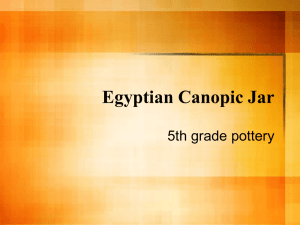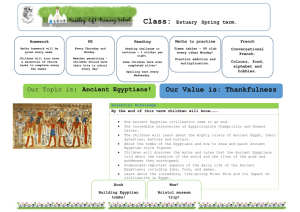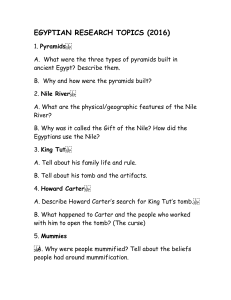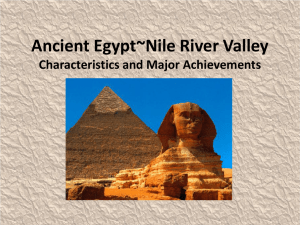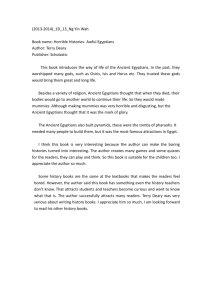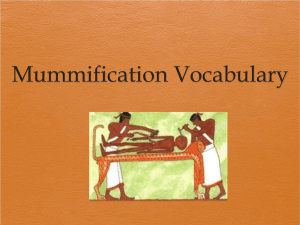File
advertisement
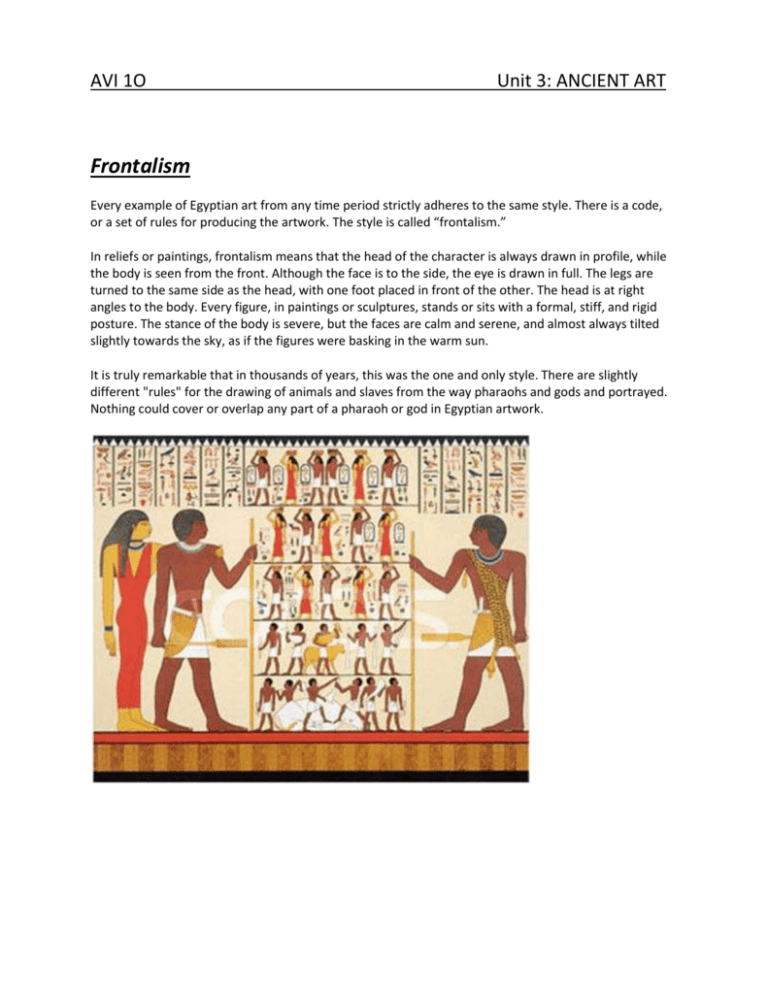
AVI 1O Unit 3: ANCIENT ART Frontalism Every example of Egyptian art from any time period strictly adheres to the same style. There is a code, or a set of rules for producing the artwork. The style is called “frontalism.” In reliefs or paintings, frontalism means that the head of the character is always drawn in profile, while the body is seen from the front. Although the face is to the side, the eye is drawn in full. The legs are turned to the same side as the head, with one foot placed in front of the other. The head is at right angles to the body. Every figure, in paintings or sculptures, stands or sits with a formal, stiff, and rigid posture. The stance of the body is severe, but the faces are calm and serene, and almost always tilted slightly towards the sky, as if the figures were basking in the warm sun. It is truly remarkable that in thousands of years, this was the one and only style. There are slightly different "rules" for the drawing of animals and slaves from the way pharaohs and gods and portrayed. Nothing could cover or overlap any part of a pharaoh or god in Egyptian artwork. AVI 1O Unit 3: ANCIENT ART Rules for Egyptian Drawing and Painting In Egyptian art, the translation of information was more important than realism. In creating Egyptian art, several rules must be followed. Rule Description Head in profile Side view of eye and eyebrow Eye never looks straight ahead Rule 1: Profile Rule 2: Colour Men often painted in red ochre Women often painted in yellow ochre Or Skin tone of women lighter than skin of men Rule 3: Stance Hips have a three-quarter turn Chest and shoulders shown at their full width Both feet, legs, arms and hands must be shown Rule 4: Scale Rule 5: Proportions Size of figures reflects social status Men are larger than women of equal status Wives and children often in crouching position, with arms around the calves of the father Hands and feet are often large compared to the rest of the body AVI 1O Unit 3: ANCIENT ART Egyptian Hieroglypics Hieroglypic are: (define/explain)_________________________________________________________________ ______________________________________________________________________________ ______________________________________________________________________________ ______________________________________________________________________________ How to Read Hieroglyphics The hieroglyphs could be read either starting at the left or the right. In order to determine the direction to begin reading is to look for a human or animal symbol. The symbol will always face in the direction that the reading should start at. Reading is always done from top to bottom (such as with columns). Hieroglyphs is made from two Greek words: hieros meaning holy glyphe meaning writing Cartouche: (define/explain)_________________________________________________________________ ______________________________________________________________________________ ______________________________________________________________________________ ______________________________________________________________________________ AVI 1O Unit 2: ANCIENT ART Mummification and the Afterlife It was very important to ancient Egyptian religious beliefs that the human body was preserved. A method of artificial preservation, called mummification was developed by the ancient Egyptians. Mummification was a complicated and lengthy process which lasted up to 70 days. A mummy is the body of a person (or an animal) that has been preserved after death. They were any Egyptian who could afford to pay for the expensive process of preserving their bodies for the afterlife. The Egyptians believed in life after death. They believed that they had to preserve their bodies so they could use them in the afterlife. The Egyptians believed that when they died, they would make a journey to another world where they would lead a new life. They would need all the things they had used when they were alive, so their families would put those things in their graves. Egyptians paid vast amounts of money to have their bodies properly preserved. Egyptians who were poor were buried in the sand whilst the rich ones were buried in a tomb. The process that the Egyptians used to preserve human bodies after death was called mummification. Mummification took a very long time, from start to finish, it took about 70 days to embalm a body. The priest in charge would wear the mask of a jackal representing the god Anubis. 1. The body was washed and purified. 2. Organs were removed. Only the heart remained. 3. The body was filled with stuffing. 4. The body was dried by covering it with a substance called natron*. This substance absorbed all the moisture from the body. 5. After 40 - 50 days the stuffing was removed and replaced with linen or sawdust. 6. The body was wrapped in strands of linen and covered in a sheet called a shroud. 7. The body was placed in a stone coffin called a sarcophagus. The mummy was now ready for its journey to the afterlife. * Natron is a natural salt, composed of sodium carbonate and sodium bicarbonate with traces of sodium chloride and sodium sulfate. It was used by the ancient Egyptians to dry out the bodies. Anubis was the god of mummification. He had a human body and the head of a jackal. His job was to prepare the bodies of the dead to be received by Osiris. Ancient Egyptians were buried with their belongings and the tomb walls were painted with scenes from the dead person’s life. The objects included furniture, games and even food was placed in the tombs for the long After Life journey! The poor Egyptians were buried in the sand. Only the rich ones were buried in a tomb In the Old and Middle Kingdoms (2628-1638 BC), Egyptian kings were buried in pyramids. About 50 royal pyramids have survived. They were built on the desert edge, west of the ancient capital of Memphis. The pyramids are the stone tombs of Egypt's kings - the Pharaohs. The Egyptians believed that if the pharaoh's body could be mummified after death the pharaoh would live forever. The tombs were designed to protect the buried Pharaoh's body and his belongings. It was very important to ancient Egyptian religious beliefs that the human body was preserved. A method of artificial preservation, called mummification was developed by the ancient Egyptians. During the process of mummification, all of the major organs were removed and placed in canopic jars. Jars used by ancient Egyptians to hold mummified remains. During the mummification process the organs of the human body were removed and preserved separately in canopic jars. The persons liver, intestines (guts), lungs and stomach were placed in canopic jars. Each organ was placed in a special jar with a top representing an animal or human head. The heart was left inside the body because the Egyptians believed that in the afterlife it would be weighed to see whether the person had led a good life. The Canopic Jars were decorated with the heads of the four sons of Horus. Each canopic jar guarded a different organ. 1. Imsety had a human head, protected the liver. 2. Qebehsenuf had the head of a falcon and guarded the intestines. 3. Hapy had a baboon head protected the lungs. 4. Duamatef had the head of a jackal, and guarded the stomach. The four canopic jars were put into a special chest which went into the tomb with the mummy. _________ ________ ________ _________ Label each jar (use the numbers from the list above)
